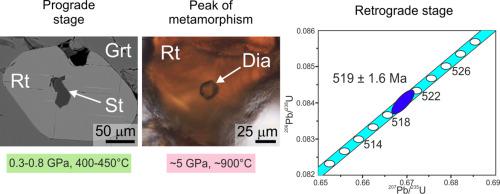Lithos ( IF 2.9 ) Pub Date : 2021-04-20 , DOI: 10.1016/j.lithos.2021.106172 Olga V. Rezvukhina , Sergey G. Skublov , Dmitriy I. Rezvukhin , Andrey V. Korsakov

|
This study highlights the usefulness of rutile when applied for reconstruction of the metamorphic evolution of ultrahigh-pressure rocks containing diamond. Within the diamondiferous kyanite gneiss (Kokchetav massif, Northern Kazakhstan), rutile shows three distinct textural positions: (i) rounded/irregular-shaped grains in the rock matrix; (ii) monomineralic inclusions in garnet, kyanite, quartz, and zircon; and (iii) grains in polyphase inclusions within garnet and kyanite porphyroblasts. High Nb (1990–3197 ppm) and relatively low Cr (404–703 ppm) concentrations in rutile indicate its metapelitic derivation. The Zr content in rutile varies from 480 to 798 ppm and the average temperature estimates yielded by the Zr-in-rutile geothermometer for 5 GPa are 880 °C. Rutile-hosted Zn-rich (up to 1.74 wt% ZnO) staurolite is interpreted as a record of the prograde metamorphic stage formed as a result of gahnite+pyrophyllite+diaspore breakdown at 0.3–0.8 GPa, 400–450 °C. Inclusions of diamond±CO2 ± carbonate±garnet in rutile originated near the peak of metamorphism (~5 GPa and ~ 880 °C). U-Pb ID-TIMS dating of a representative rutile separate yielded a concordant age of 519 ± 1.6 Ma that is younger than the previously estimated U-Pb crystallization ages of the peak metamorphic assemblages of the Kokchetav massif (528 ± 3 Ma). The obtained age represents the timing of cooling to the closure temperature for Pb diffusion in rutile (Tc; 420–640 °C). The cooling of the rocks from the peak temperatures to Tc occurred with the rates of 27–51 °C/Ma, whereas the exhumation rates (from 880 °C and 5 GPa to 420–640 °C and 0.5–1 GPa) were 1.3–1.5 cm/year. The peak temperature estimates as well as rapid cooling and exhumation rates reported here are in agreement with published data on zircon from similar diamondiferous Kokchetav gneisses. This work demonstrates that rutile provides a beneficial tool in studies dealing with reconstruction of the metamorphic evolution of diamondiferous rocks.
中文翻译:

金刚石变质岩中的金红石:微量元素组成,矿物/流体包裹体和U-Pb ID-TIMS测年的新见解
这项研究强调了金红石在用于重建含金刚石的超高压岩石的变质演化中的有用性。在含钻石的蓝晶岩片麻岩(哈萨克斯坦北部的科克切塔夫地块)中,金红石显示出三个不同的纹理位置:(i)岩石基质中的圆形/不规则形状的晶粒;(ii)石榴石,蓝晶石,石英和锆石中的单矿物内含物;(iii)石榴石和蓝晶石卟啉岩中多相夹杂物中的晶粒。金红石中的高Nb(1990–3197 ppm)和相对较低的Cr(404–703 ppm)浓度表明其成岩作用。金红石中的Zr含量在480 ppm至798 ppm之间,并且金红石型Zr地热仪在5 GPa的温度下得出的平均温度估计为880°C。金红石型富锌(最高1。74 wt%的ZnO)辉石被解释为在0.3-0.8 GPa,400-450°C的条件下,针铁矿+叶蜡石+辉绿岩分解而形成的渐进变质阶段的记录。金刚石±CO夹杂物金红石中的2 ±碳酸盐±石榴石起源于变质峰附近(〜5 GPa和〜880°C)。U-Pb ID-TIMS年代测定法对金红石的代表性分离产生的一致年龄为519±1.6 Ma,比Kokchetav断层峰变质组合的峰值U-Pb结晶年龄(528±3 Ma)的先前估计年龄年轻。所获得的年龄代表了金红石中铅扩散至冷却至封闭温度的时间(T c; 420–640°C)。从峰值温度到T c的岩石冷却发生的速率为27–51°C / Ma,而尸体的发掘速率(从880°C和5 GPa到420–640°C和0.5–1 GPa)为1.3–1.5 cm /年。此处报告的峰值温度估算值以及快速的冷却和发掘速率与来自类似菱形科科奇察夫片麻岩的锆石的公开数据相符。这项工作表明,金红石在研究重建菱形变质岩的研究中提供了有益的工具。











































 京公网安备 11010802027423号
京公网安备 11010802027423号